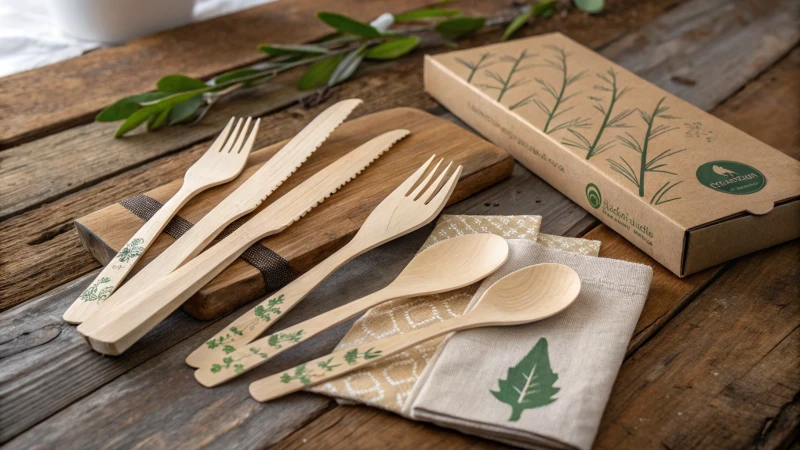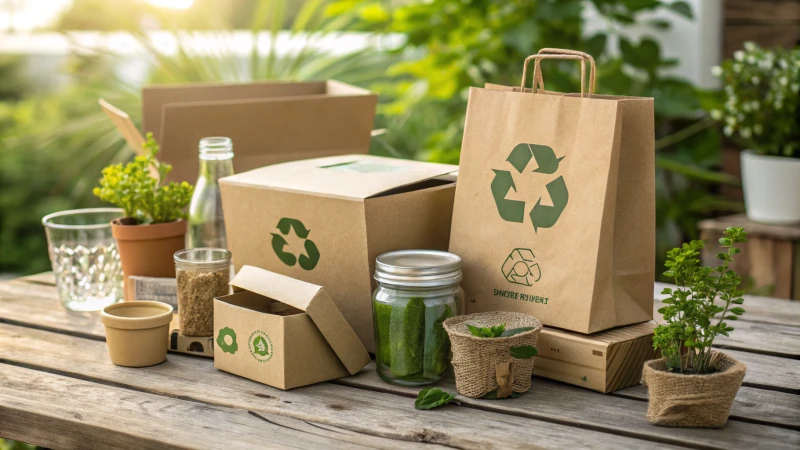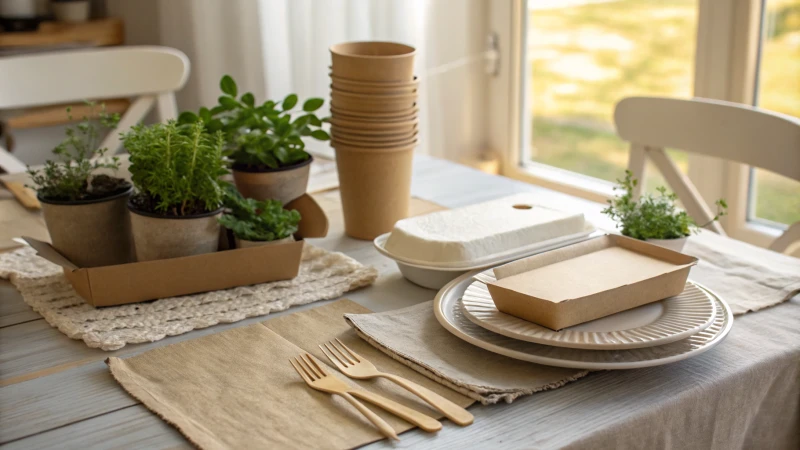
Ever wondered why you pick one set of wooden cutlery over another?
The design and packaging of disposable wooden cutlery can significantly sway consumer decisions by merging visual allure with eco-friendly messaging. When packaging highlights sustainability, it can elevate perceived value, aligning with consumer priorities and prompting a preference for these over plastic alternatives.
I remember the first time I encountered beautifully packaged wooden cutlery at a cafe. It wasn’t just the rustic charm that caught my eye but the way the packaging seemed to whisper promises of a more sustainable future. While the aesthetic appeal initially drew me in, it was the underlying message of environmental responsibility that sealed the deal. This experience made me realize how effective design and packaging go beyond mere looks—they convey a brand's values and commitments. By focusing on thoughtful design and clear messaging, companies can not only catch the consumer's eye but also speak to their eco-conscious values, ultimately transforming perceptions and boosting market appeal.
Attractive packaging increases sales of wooden cutlery.True
Visually appealing packaging can enhance perceived value, boosting sales.
Plastic cutlery is preferred over wooden due to design.False
Consumers often prefer wooden cutlery for its eco-friendly appeal.
How Does Aesthetic Appeal Influence Consumer Choices?
Ever noticed how some products just call out to you, while others seem invisible?
Aesthetic appeal plays a crucial role in consumer choices by triggering emotions, boosting perceived value, and setting products apart in crowded markets. Elements like color, design, and packaging can shape perceptions and drive purchasing decisions.

The Emotional Connection
Aesthetic appeal taps into our emotions. I remember the first time I bought a product just because it looked good. It was a sleek, minimalist gadget that caught my eye with its vibrant blue hue—a color known to evoke feelings of trust and calmness. That emotional pull was irresistible. Colors like blue can indeed evoke trust, while red stirs excitement, steering us toward certain choices without us even realizing it. Take eco-friendly products, for example. They often feature green hues to signify sustainability, tapping into our growing environmental awareness.
Perceived Value Enhancement
Well-designed packaging can make a product seem more valuable. Think about the last time you splurged on a luxury item. For me, it was a beautifully packaged bottle of perfume. The intricate design of the bottle made it feel more valuable, justifying the higher price tag in my mind. This perceived value is powerful; we often equate aesthetics with quality.
| Brand Type | Aesthetic Strategy | Consumer Perception |
|---|---|---|
| Luxury | Elegant and Minimalistic | High Quality, Exclusive |
| Eco-Friendly | Natural Colors and Textures | Sustainable, Trustworthy |
| Tech Products | Sleek and Modern | Innovative, Cutting-edge |
Luxury brands know this well, and their elegant and minimalistic packaging is a testament to their high-quality and exclusive image.
Differentiation in Competitive Markets
In today's market, where we're flooded with options, aesthetics can be a game-changer. In markets flooded with options, aesthetics differentiate products. I once picked up a tech gadget purely because of its unique design—it was so memorable! A distinctive look can make a product stand out and linger in our minds long after we've seen it.
Minimalist designs in tech gadgets often appeal to those of us who value simplicity and functionality.
Aesthetics and Eco-Friendly Products
Sustainability is becoming more important to consumers like you and me every day. Products that visually communicate eco-friendliness through their design or materials often catch our attention more effectively. I’ve noticed the rise in popularity of wooden cutlery with natural finishes. They offer aesthetic appeal while also providing environmental benefits, making them an easy choice for those of us who care about sustainability.
This trend can be seen in the rise of wooden cutlery with natural finishes, offering both aesthetic appeal and environmental benefits.
Incorporating Consumer Feedback
Listening to what consumers want is key to refining aesthetic strategies. Understanding consumer preferences allows brands to refine their aesthetic strategies by adapting their designs based on customer feedback—it's like having a direct line to what truly resonates with buyers.
Surveys and reviews provide insights into what resonates with buyers. Brands that take this approach often find greater success because they're tailoring their offerings to meet our preferences, ensuring we feel seen and valued.
By leveraging these aesthetic elements, brands can not only attract but also retain us as consumers consumer behavior1, ensuring our loyalty in the long run.
Green hues in packaging signify sustainability.True
Green is commonly associated with eco-friendliness, influencing consumer perceptions.
Minimalist designs are unpopular in tech products.False
Minimalist designs are popular for their simplicity and modern appeal.
How can packaging communicate sustainability effectively?
Ever wondered how a simple packaging choice can tell a powerful sustainability story?
Sustainable packaging effectively communicates eco-friendliness through thoughtful materials, intentional design, and clear messaging. By opting for recyclable materials, incorporating universal eco-symbols, and using nature-inspired colors, brands can align their packaging with environmental values, boosting consumer trust and loyalty.

The Importance of Material Choice
When I first started exploring sustainable packaging, I realized how crucial material choice is. It felt like choosing the right ingredients for a recipe that reflects both taste and health. Opting for recyclable or biodegradable materials like recycled paper2 or compostable plastics seemed like small changes at first, but they quickly became fundamental steps toward reducing our environmental footprint. These choices do more than just communicate our commitment to sustainability; they set a positive example in the industry.
Design Elements That Speak Green
I remember the first time I experimented with eco-friendly design; it was a revelation. Imagine a palette of earthy greens and browns—colors that almost whisper 'nature' to you. Eco-friendly design isn’t just about aesthetics; it’s about creating a message that resonates. Minimalist designs use less ink and resources, reducing environmental impact, and symbols like the Mobius loop3 become powerful reminders of recycling and responsibility.
Messaging and Transparency
Clear messaging on packaging can really shape consumer perceptions. It's like having an honest conversation with your customers about what you stand for. Sharing information about recycled content or disposal instructions builds trust. Including a note about our commitment to reducing carbon footprints isn’t just informative; it’s a pledge that connects deeply with eco-conscious consumers.
| Feature | Sustainable Practice |
|---|---|
| Material | Use recyclable or biodegradable materials |
| Color Scheme | Earth tones like green and brown |
| Design | Minimalist approach to save ink and resources |
| Symbols | Use universally recognized eco-symbols |
| Messaging | Include clear information about environmental impact |
Innovative Approaches to Packaging
Innovation in sustainable packaging opened my eyes to endless possibilities. Imagine scanning a QR code on your package and uncovering the story behind our sustainability efforts. These smart features not only engage consumers but also allow us to reduce packaging size while maintaining quality, contributing to waste reduction4.
Case Studies: Leading by Example
Looking at brands that have embraced sustainable packaging has been incredibly enlightening. I recall one company that switched from plastic to biodegradable materials—it wasn't just their sales that increased; consumer trust soared as well. These examples are living proof of the real benefits that come from investing in sustainable packaging practices.
Recycled paper reduces environmental impact of packaging.True
Recycled paper is a sustainable choice, lowering waste and resource use.
Minimalist designs increase the use of ink in packaging.False
Minimalist designs use less ink, reducing environmental impact and resources.
Why Is Functionality Important in the Design of Wooden Cutlery?
I remember my first picnic with wooden cutlery—it wasn't just about going green, but about finding tools that actually worked. So, what makes functionality in wooden cutlery design so crucial? Let's dive in!
The functionality of wooden cutlery is essential as it ensures ease of use, comfort, and reliability, enhancing the overall dining experience. Well-crafted utensils provide a firm grip, prevent breakage, and promote sustainable practices, making them a practical choice for eco-conscious consumers.

Enhancing User Experience Through Design
Think back to a family barbecue where the flimsy plastic fork snapped mid-bite. That frustration is exactly what well-designed wooden cutlery aims to avoid. A good set should sit comfortably in your hand, whether you're young or old. Imagine picking up a perfectly sized spoon that feels just right as you savor your soup—there's no awkward angle or struggle, just smooth dining.
Consider how a fork with finely crafted prongs can make spearing food easier, reducing user frustration. Similarly, a spoon with a deep bowl may improve soup consumption5 efficiency.
Balancing Aesthetic and Practical Needs
I once attended a fancy outdoor wedding where everything was picture-perfect, right down to the wooden cutlery. It wasn't just the elegant look that caught my eye; it was how effortlessly it sliced through the gourmet meals without losing its edge. That's the magic of combining form and function—when a knife not only looks sharp but actually is sharp, yet safe.
| Feature | Importance in Functionality |
|---|---|
| Ergonomic Design | Reduces user fatigue |
| Durability | Prevents breakage during use |
| Grip | Ensures comfort and control |
Supporting Sustainable Practices
Every time I choose wooden over plastic, I'm reminded of my commitment to sustainability. It's like a small victory for the planet every time my utensils don't end up in a landfill. Sturdy, biodegradable options mean less waste and more guilt-free meals. Plus, knowing that the wood is sourced sustainably gives that extra peace of mind.
For instance, using wood from renewable sources bolsters sustainability credentials. Certifications6 confirming eco-friendly production reassure us of ethical practices.
Meeting Diverse Market Demands
Different scenarios call for different designs. In hospitality, cutlery that withstands heat and retains its shape can be the difference between a good meal and a great one. As someone who frequently orders online, I've noticed how well-thought-out packaging not only saves on shipping costs but also keeps everything pristine when it arrives. It's these thoughtful touches that truly make functionality essential in wooden cutlery design.
In summary, while aesthetics draw initial attention, the true test of wooden cutlery lies in its functionality—ensuring it meets diverse user needs and supports broader sustainability goals.
Ergonomic design reduces user fatigue.True
Ergonomic design ensures comfort during use, minimizing strain and fatigue.
Aesthetic appeal is more important than functionality.False
Functionality retains customer loyalty by ensuring ease of use and safety.
What Are the Market Trends in Eco-Friendly Dining Solutions?
Ever wondered how your dining choices could help save the planet? Join me as we delve into the world of eco-friendly dining solutions, where sustainability meets style.
Eco-friendly dining solutions are gaining momentum as more people demand sustainable options. Key trends include biodegradable packaging, plant-based cutlery, and minimalist design, all focusing on aesthetics and environmental impact.

Sustainable Materials and Biodegradables
I've always been fascinated by how simple changes in what we use daily can significantly impact our environment. One such change is moving away from single-use plastics to sustainable materials. Remember the first time I swapped out a plastic straw for a bamboo one? It felt like a small victory for Mother Earth. Now, businesses are leading the charge by adopting bamboo, cornstarch, and compostable7 materials that naturally break down, reducing our ecological footprint.
Table: Popular Eco-Friendly Materials
| Material | Description | Benefits |
|---|---|---|
| Bamboo | Fast-growing plant, durable | Renewable, strong |
| Cornstarch | Used in PLA production | Biodegradable, plant-based |
| Compostable | Breaks down naturally | Reduces landfill waste |
Design Trends: Minimalism and Functionality
In my quest for simplicity, I've noticed a growing trend towards minimalist design in dining solutions. It’s more than just a style; it's a movement that aligns perfectly with sustainable living. I remember the joy of dining with sleek, functional cutlery that felt like art in my hands—less is truly more. These designs not only please the eye but also conserve materials, echoing the desires of those seeking both beauty and responsibility.
Table: Design Principles in Eco-Friendly Solutions
| Principle | Description |
|---|---|
| Minimalism | Simple designs with fewer materials |
| Functionality | Practical use with minimal waste |
| Aesthetics | Visually appealing, natural look |
The Rise of Plant-Based Cutlery
Every time I pick up plant-based cutlery, I’m reminded of how innovative yet simple solutions can make a difference. These utensils are crafted from renewable resources like cornstarch and sugarcane, turning what was once waste into something wonderfully useful. They’re not just biodegradable; they often contribute back to the earth as compostable8 material.
- Benefits of Plant-Based Cutlery
- Made from renewable sources like cornstarch and sugarcane.
- Biodegradable9, reducing landfill waste.
- Often compostable, returning nutrients to the soil.
The shift towards sustainability in dining isn't just about meeting consumer demands—it's about paving the way for a healthier planet. Companies are innovating to not only capture eco-conscious consumers but also gain a competitive edge in this ever-evolving market. Embracing these trends could very well be our ticket to a greener future.
Bamboo is a non-renewable resource.False
Bamboo is a renewable resource due to its fast growth rate.
Minimalist designs reduce material usage.True
Minimalist designs focus on simplicity, using fewer materials.
Conclusion
The design and packaging of disposable wooden cutlery significantly influence consumer choices by enhancing perceived value, promoting sustainability, and creating emotional connections through aesthetics.
-
Explore how different colors impact emotions and consumer decisions, crucial for effective marketing strategies. ↩
-
Explore the benefits of using recycled paper in packaging to understand how it enhances eco-friendliness. ↩
-
Learn about the significance of the Mobius loop to effectively communicate recycling efforts. ↩
-
Discover how smart packaging innovations can help reduce waste and improve sustainability. ↩
-
Discover how ergonomic designs enhance dining comfort and efficiency. ↩
-
Explore certifications that ensure your wooden cutlery is sustainably sourced. ↩
-
Discover materials that decompose naturally, offering an eco-friendly alternative to traditional options. ↩
-
Explore the benefits of plant-based cutlery and its role in reducing landfill waste. ↩
-
Explore the benefits of plant-based cutlery and its role in reducing landfill waste. ↩

